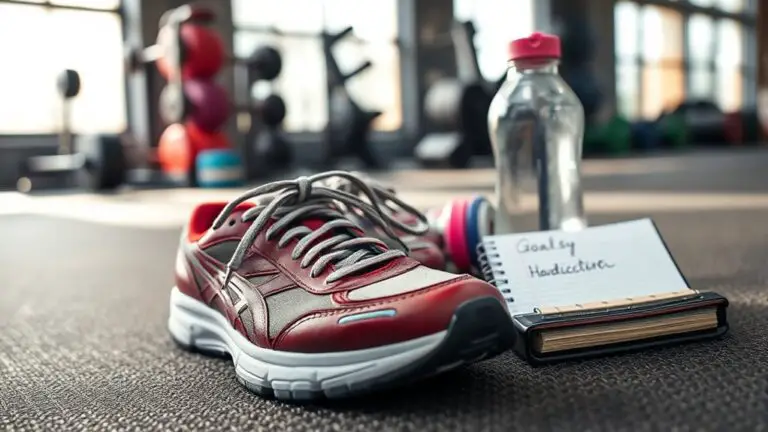The Best Gym Training Program for Military Fitness Tests
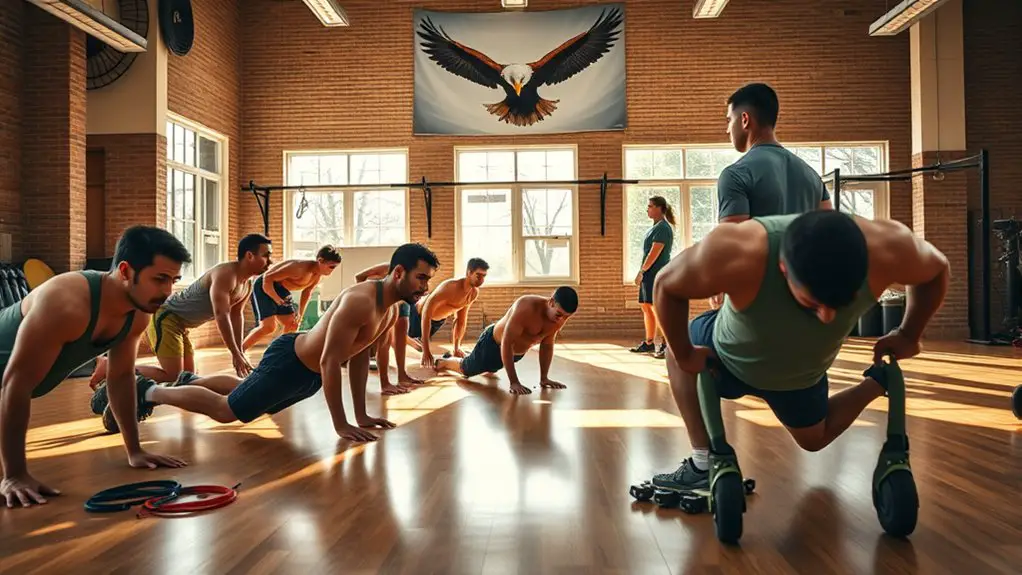
To excel in military fitness tests, focus on a structured gym program that balances strength, endurance, agility, and flexibility. Incorporate compound movements like squats and deadlifts to build strength, while adding interval running and circuit training to boost endurance. Don’t forget dynamic stretching and agility drills for tactical advantage. Nutrition plays a key role too; prioritize balanced meals and hydration for ideal recovery. Keep pushing your limits, and there’s more to discover on perfecting your training approach.
Understanding Military Fitness Test Requirements
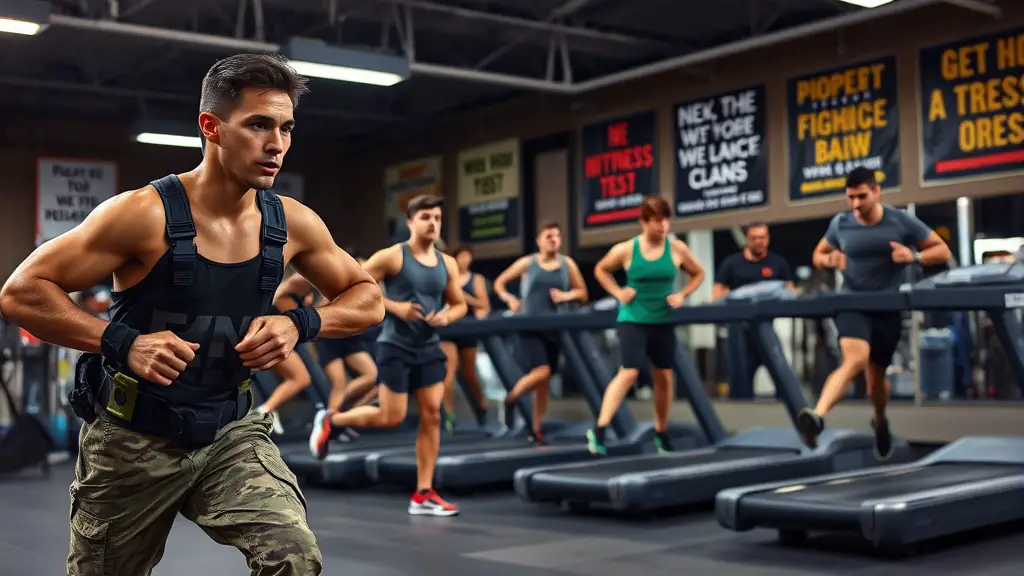
When you’re preparing for military fitness tests, it’s essential to understand the specific requirements, as these standards can vary by branch and role. Each branch of the military has its own set of fitness assessments designed to evaluate your physical readiness. Familiarize yourself with the key components—whether it’s running, push-ups, sit-ups, or other exercises. Knowing the military standards will help you identify your strengths and areas for improvement.
You’ll want to create a training plan that aligns with these requirements. Assess your current fitness level and set realistic goals. Consistency is vital; make sure you’re training regularly and progressively to meet or exceed the standards. Additionally, consider incorporating recovery and nutrition into your regimen to optimize performance. By understanding the expectations and committing to your training, you’re setting yourself up for success in achieving your military fitness goals. Stay focused and push yourself; you’ve got this!
Key Components of a Military-focused Training Program
To excel in military fitness tests, you need to focus on three key components: strength training, endurance and stamina, and agility and flexibility. Each element plays a critical role in ensuring you can meet the demands of military operations. By integrating these components into your training program, you’ll build a well-rounded fitness foundation that sets you up for success.
Strength Training Essentials
Although strength training might seem like just another component of fitness, it’s actually a cornerstone of military readiness that you can’t afford to overlook. To excel in military fitness tests, you need to master a variety of strength training techniques. Focus on compound movements like squats, deadlifts, and bench presses, which engage multiple muscle groups, building both strength and stability.
Incorporating progressive overload will help you continually challenge your muscles, ensuring they adapt and grow. Don’t forget about muscle recovery strategies; allowing time for your body to heal is essential. Implement techniques like stretching, foam rolling, and adequate sleep to enhance recovery. With a solid strength training foundation, you’ll be better prepared to face the physical demands of military service.
Endurance and Stamina
While strength is essential, endurance and stamina are equally important for meeting the rigorous demands of military fitness tests. To build your endurance, incorporate effective cardio workouts into your training regimen. Here are three key stamina boosters to focus on:
- Interval Training: Alternate between high-intensity bursts and lower-intensity recovery periods. This enhances cardiovascular capacity and builds stamina quickly.
- Long-Distance Runs: Gradually increase your running distance to improve your aerobic endurance. Aim for consistent pacing over time.
- Circuit Training: Combine bodyweight exercises with short cardio bursts. This keeps your heart rate elevated while building strength and endurance simultaneously.
Agility and Flexibility
Incorporating agility and flexibility into your training routine is vital for excelling in military fitness tests, as these components enhance your overall athletic performance. Start with dynamic stretching to improve your range of motion and reduce injury risk. This can include leg swings, arm circles, and torso twists, all designed to prepare your body for intense movements. Next, integrate balance training exercises, such as single-leg stands or stability ball workouts, to enhance coordination and body control. These skills are essential in high-pressure situations, where quick decisions and movements are required. Remember, a well-rounded approach to agility and flexibility not only boosts your fitness scores but also prepares you mentally for the challenges ahead. Stay focused and consistent for best results!
Strength Training Strategies for Optimal Performance
To excel in military fitness tests, implementing targeted strength training strategies is essential for building the power and endurance required for peak performance. Here are three effective strategies to incorporate into your routine:
- Powerlifting Techniques: Focus on compound lifts like squats, deadlifts, and bench presses. These exercises build overall strength and enhance your explosive power, critical for performance in military tasks.
- Resistance Band Workouts: Use resistance bands for dynamic movements that improve stability and muscle endurance. They’re versatile and great for targeting specific muscle groups without heavy weights.
- Progressive Overload: Gradually increase the weight or resistance in your workouts. This method guarantees continuous muscle growth and adaptation, essential for meeting the demands of military fitness tests. Additionally, incorporating exercises like Turkish Get Up can enhance overall stability and strength, which are crucial for military performance.
Endurance Building Techniques for Military Readiness
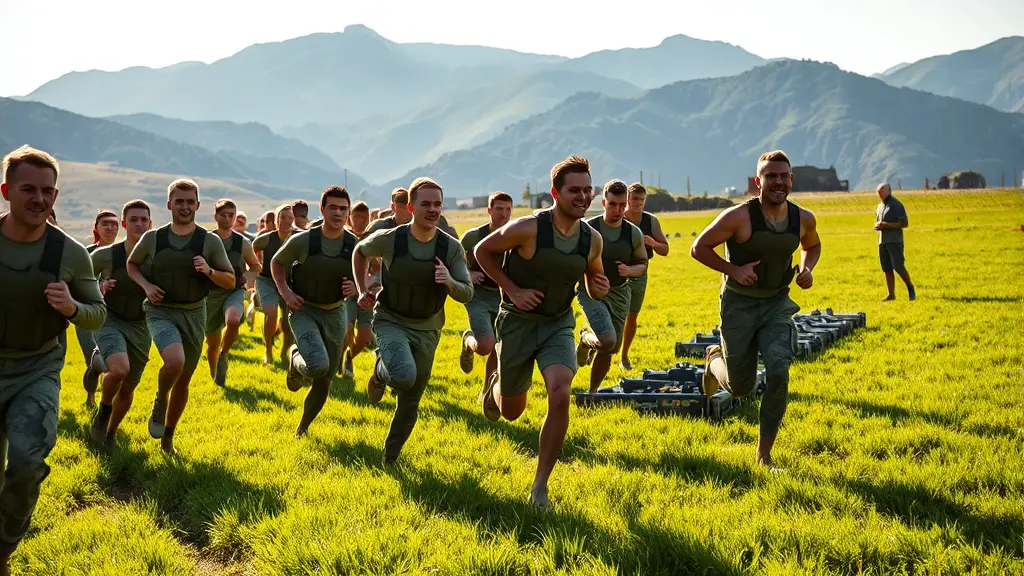
To excel in military fitness tests, you need to focus on endurance building techniques that push your limits. Incorporating running interval training, circuit training, and cross-training activities can greatly enhance your stamina and overall performance. Let’s explore how these methods can prepare you for the demands of military readiness.
Running Interval Training
While many believe long-distance running is the key to building endurance for military fitness tests, integrating running interval training can greatly enhance your performance. This method focuses on alternating between high-intensity bursts and recovery periods, optimizing your overall stamina. Here are three effective running techniques to incorporate into your interval workouts:
- Sprint Intervals: Alternate between 30 seconds of sprinting and 1-2 minutes of jogging to recover.
- Hill Sprints: Find a hill and sprint up for 20-30 seconds, then walk down to recover. This builds strength and power.
- Fartlek Training: Mix periods of fast running with slower paces during a longer run, enhancing speed and endurance.
Circuit Training Benefits
Circuit training offers a dynamic approach to building endurance essential for military readiness. By incorporating various circuit variations, you can target different muscle groups while maintaining high workout intensity. This method keeps your body engaged, preventing plateaus and enhancing overall performance.
You’ll alternate between strength exercises and cardio, maximizing your stamina and functional fitness. As you progress, you can modify the circuits to include more challenging moves or increase the duration of each station. This not only builds endurance but also improves mental toughness—critical for military tasks.
Stay consistent, push your limits, and watch as your endurance skyrockets, preparing you for the demands of military fitness tests. Embrace the challenge, and let circuit training shape your readiness.
Cross-Training Activities
Incorporating cross-training activities into your regimen is a game changer for building endurance and enhancing military readiness. Not only do they prevent burnout, but they also improve your overall fitness by engaging different muscle groups. Here are three effective cross-training examples to examine:
- Swimming: This low-impact exercise boosts cardiovascular fitness while being easy on your joints.
- Cycling: Whether outdoors or stationary, cycling increases your leg strength and endurance without the wear and tear of running.
- Rowing: It’s a full-body workout that enhances both strength and stamina, making it ideal for military demands.
Agility and Flexibility Drills for Tactical Advantage
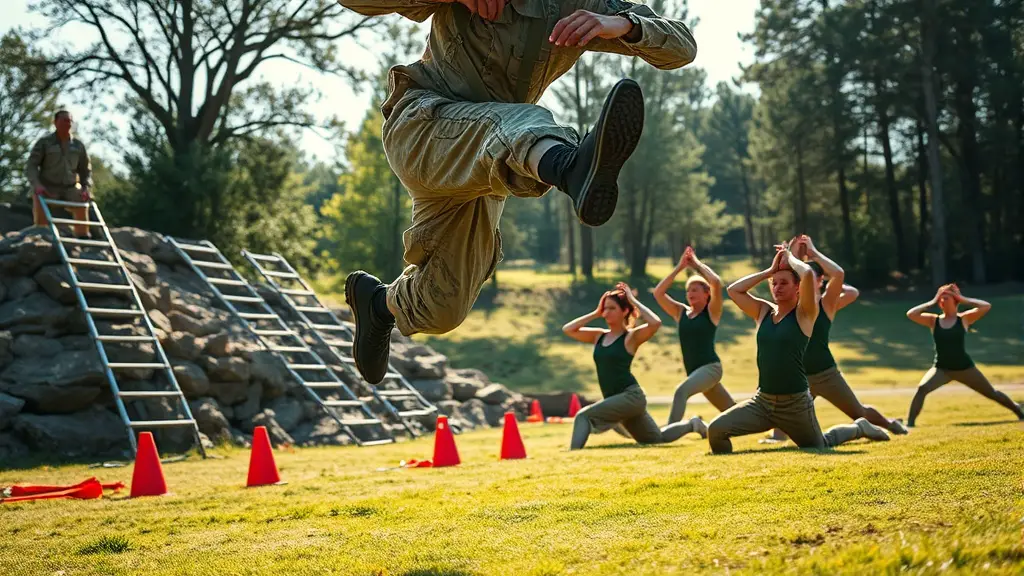
To gain a tactical advantage on the battlefield, mastering agility and flexibility is essential for any service member. Start your training with dynamic warm-ups to activate your muscles and prepare your body for action. Incorporate agility ladders into your routine; they’re perfect for enhancing foot speed and coordination. Try drills like lateral shuffles and high knees to challenge your reflexes and improve your reaction time.
Next, add flexibility routines to your regimen. These not only prevent injuries but also enhance your mobility during tactical maneuvers. Focus on stretches that target major muscle groups, such as hip flexors and hamstrings, to maintain ideal range of motion.
Finally, include tactical drills that simulate real-life scenarios. Practicing quick changes in direction and body positioning under pressure will sharpen your skills. By prioritizing agility and flexibility, you’ll enhance your overall performance and readiness for any mission ahead.
Nutrition and Recovery Tips to Enhance Training Outcomes
Nutrition plays an essential role in maximizing your training outcomes, especially for military fitness tests. To enhance your performance, you need to focus on meal timing and hydration strategies. Here are three key tips:
- Meal Timing: Fuel your body with a balanced meal 2-3 hours before training. Include complex carbs, lean protein, and healthy fats to provide sustained energy.
- Hydration Strategies: Stay hydrated throughout the day. Aim for at least 3 liters of water daily, adjusting for sweat loss during intense workouts. Consider electrolyte drinks during prolonged sessions.
- Post-Workout Recovery: Refuel within 30 minutes after training with a protein-rich snack. This helps muscle recovery and rebuilds glycogen stores.
Frequently Asked Questions
How Often Should I Re-Test My Fitness Levels During Training?
Did you know that regular fitness assessments can boost your motivation by up to 30%? To track your progress effectively, aim to re-test your fitness levels every 4-6 weeks. This frequency allows you to adjust your training program based on your results, ensuring continuous improvement. Use various progress tracking methods like performance logs or fitness apps to keep yourself accountable and motivated. Consistent assessments help you stay on course and achieve your goals!
What Equipment Do I Need for a Military Fitness Program?
To excel in a military fitness program, you’ll need a few essential pieces of equipment. Start with weights for strength training, like dumbbells or kettlebells, to build muscle. Resistance bands can also enhance your workouts. For endurance drills, a jump rope or agility ladder is great for improving cardiovascular fitness. Don’t forget a sturdy mat for bodyweight exercises. With this gear, you’re set to conquer your fitness goals and prepare effectively!
Can I Train Alone or Should I Find a Partner?
Imagine training like a lone wolf, fierce and determined. Solo training can be effective, letting you focus solely on your goals. However, don’t underestimate the partner benefits. A workout buddy can push you harder, keep you accountable, and make sessions more enjoyable. When you’re feeling low, they’ll be there to motivate you. Ultimately, it’s about finding what drives you best—whether that’s the solitude of solo training or the camaraderie of a partner.
How Do I Stay Motivated Throughout My Training?
To stay motivated throughout your training, focus on goal setting and progress tracking. Break your larger goals into smaller, achievable milestones, and celebrate each one. Keep a journal or use an app to track your workouts and progress; seeing how far you’ve come can boost your motivation. Surround yourself with supportive people, and don’t forget to mix things up to keep your routine fresh. Consistency combined with a positive mindset will keep you driven!
What Common Mistakes Should I Avoid While Preparing?
When preparing for any fitness challenge, avoid common mistakes like poor form and setting unrealistic goals. Poor form can lead to injuries, so focus on technique over quantity. Set achievable milestones to keep you motivated; aiming too high too fast can lead to frustration and burnout. Track your progress, celebrate small victories, and adjust your goals as needed. Stay disciplined, and remember that consistency is key to success in your training journey.
